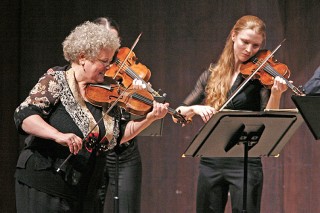Title

Monica Huggett (left) will lead Juilliard415 in Beethoven’s First Symphony and other works.
(Photo by Jennifer Taylor)If there is one thing my Historical Performance education at Juilliard has taught me, it is that nothing in music can be taken for granted. There is so much more to music than the little black dots on the page: there are questions of style, aesthetic, and historical context, just to name a few topics. The picture of a singular piece of music is much bigger than the edition found on our music stands—an example is Beethoven’s First Symphony, which Juilliard415 will perform on December 9 under the direction of Monica Huggett.
Body
As the orchestra prepares for its concert, we have to consider the unusual circumstances surrounding the premiere of the First Symphony, circumstances that are unusual especially given our contemporary concert practices. The concert was held at the Burgtheater in Vienna on April 2, 1800, and the theater’s own orchestra performed it. One could have gone to the box office to purchase a seat—or gone directly to Beethoven, who sold tickets from his apartment. The repertoire also presents a stark contrast from what audiences today are accustomed to. It consisted of a hodgepodge of music: a Mozart symphony, two selections from Haydn’s Creation, a piano concerto as well as some improvisations on the piano by Beethoven, the premiere of his then-and-now popular Septet, and the premiere of his First Symphony.
By all estimates, this monstrous program could have lasted more than three hours and might have put substantial strain on the orchestra members. Perhaps it was for this reason that a correspondent for the publication Allgemeine musikalische Zeitung commented that the orchestra made a poor showing of the Beethoven symphony and reported that “the gentlemen refused to play under him,” especially criticizing the wind instruments for their lackluster performance. The length of the concert alone makes one sympathetic to the wind section: the horns and the bassoons in particular would have likely been called to play in every piece save the piano improvisations. But while the correspondent criticized the winds, he also conceded that their parts were very difficult in their own right, a sentiment that resonates today with the Juilliard415 wind section.
As historical performers, we think about the historical context a great deal, especially when it directly influences our individual artistry. In the case of historical performance winds and brass, the topic of the instrument itself (known as organology) presents the most immediate influence on our artistry and approach to the music, owing to the profound differences between the modern and historical counterparts.
Having performed the First Symphony on modern bassoon and soon the historical bassoon, I can attest to these differences in the two instruments and how that has influenced my own approach. For me, a substantial difference has been that historical bassoons tend to have more flexibility when it comes to tuning each note. My experience on historical bassoons is much shorter compared to my experience on modern bassoon (just under 2 years versus 13 years), and it has often felt like the modern bassoon is more stable when producing any given pitch. But experience with the idiosyncrasies of the older instruments has opened up a whole new realm of tuning possibilities and color changes that directly inform how I approach the music.
The increasingly chromatic demands of Beethoven’s music make the intonation issue a great challenge for me because of the particular issues with certain notes. It has given me an appreciation for the stability of the modern instrument as well as an appreciation for what I have found to be one of the greatest assets of the historical one. For example, on a historical bassoon, the A section in the third movement of the symphony presents a challenge when the music shifts from C major to D-flat major. The particular challenge of this key lies in the tuning of the notes G flat, D flat, and A flat. In its historical context, this harmonic shift is intensely dramatic, the drama of which is felt and heard all the better on historical instruments given the difficult nature of D-flat major. Beyond the issue of intonation, Beethoven’s music also reflects the trend at the time of expanding the capabilities of performers and presents technical challenges in terms of range, technique, and projection that are not as apparent on modern instruments.
These issues of historical context and organology are just the beginning stages of informing our approach to music of the past. The next step would be to consider musical topics such as phrasing and articulation, at which point we consult various treatises and sources to inform our playing. While we may not be able to answer every question about the way Beethoven’s First Symphony was played at its premiere to our satisfaction, asking and attempting to answer the questions we raise help to give us new insight into the performers’ way of thinking and help to inform the way we might approach it today, which is the true goal of historical performance.




